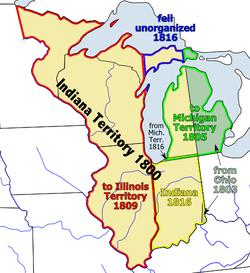Indiana Territory
| Territory of Indiana | |||||
| Organized incorporated territory of the United States | |||||
|
|||||
|
Flag |
|||||
| Capital |
Vincennes (1800–1813) Corydon (1813–1816) |
||||
| Government | Organized incorporated territory | ||||
| Governor | |||||
| • | 1800–1812 | William Henry Harrison | |||
| • | 1812–1813 | John Gibson (acting) | |||
| • | 1813–1816 | Thomas Posey | |||
| Secretary | |||||
| • | 1800–1816 | John Gibson | |||
| History | |||||
| • | Established | July 4, 1800 | |||
| • | Treaty of Grouseland signed | March 1805 | |||
| • | Michigan Territory created | June 30, 1805 | |||
| • | Representation in Congress | December 12, 1805 | |||
| • |
Illinois Territory created - Treaty of Fort Wayne - Legislature popularly elected - Tecumseh's War - War of 1812 - Constitution drafted & adopted |
March 1, 1809 September 30, 1809 November 1809 1811–1812 1812–1814 June 1816 |
|||
| • | Granted Statehood | December 11, 1816 | |||
| Population | |||||
| • | 1800 | 2,632 | |||
| • | 1810 | 24,520 | |||
| • | 1816 | 63,897 | |||
Flag
The Territory of Indiana was an organized incorporated territory of the United States that existed from July 4, 1800, until December 11, 1816, when the remaining southern portion of the territory was admitted to the Union as the state of Indiana.
The Indiana Territory was created by an Act of Congress and signed into law by President John Adams on May 7, 1800, effective on July 4. It was the first new territory created from lands of the Northwest Territory, which had been organized in 1787 by the Northwest Ordinance. The territory originally contained approximately 259,824 square miles (672,940 km2) of land, but twice decreased in size as it was further subdivided into new territories (Michigan Territory and Illinois Territory).
The territory was first governed by William Henry Harrison who oversaw the negotiation with the native inhabitants to open large parts of the territory to settlement. In 1810 a popularly elected government was established as the territory continued to grow in population and develop a very basic road network, government, and education system. At the outbreak of Tecumseh's War, the territory was on the front line of battle and Harrison led a military force in the opening hostilities at the Battle of Tippecanoe, and then in the subsequent invasion of Canada during the War of 1812. Thomas Posey was appointed to the vacant governorship, but the opposition party, led by Congressman Jonathan Jennings, had dominance in the territorial affairs for its remaining years and began pressing for statehood. In June 1816, a constitutional convention was held and a state government was formed. The territory was dissolved on December 11, 1816, by an act of Congress granting statehood to Indiana.
...
Wikipedia


